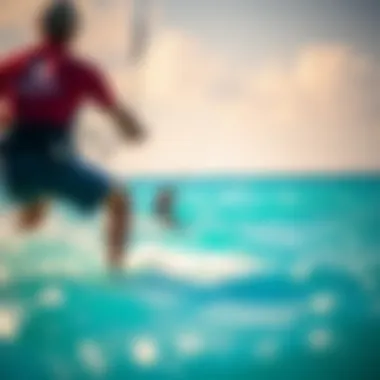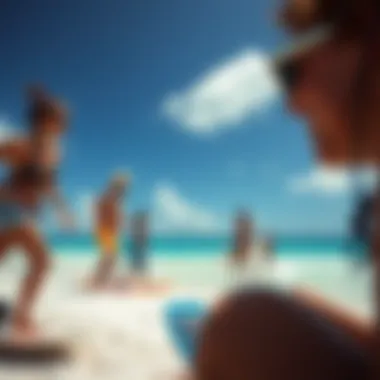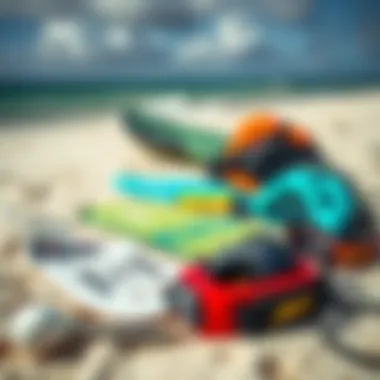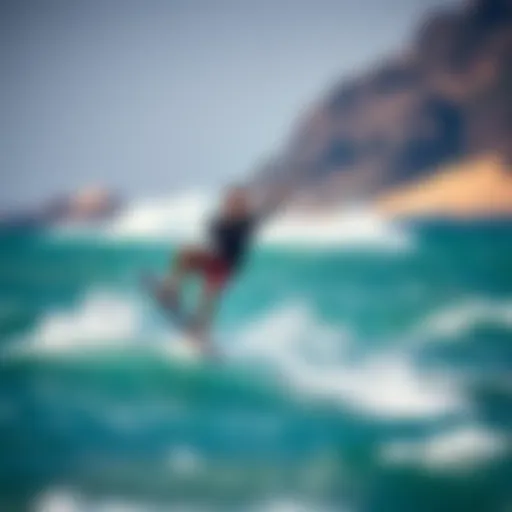Kiteboarding in Turks and Caicos: Your Complete Guide


Intro
Kiteboarding has captured the hearts of many adventure seekers, offering an exhilarating mix of speed, skill, and connection with nature. In the stunning landscape of Turks and Caicos, this sport finds its ideal playground. The crystal-clear waters and consistent winds transform this tropical paradise into a kiteboarder's dream. As one gazes onto the horizon, the sight of brightly colored kites dancing against a backdrop of swaying palm trees sets an unforgettable scene.
In this guide, we will take you through the essentials of kiteboarding in Turks and Caicos. From navigating the unique geographical advantages of these islands to the necessary gear and techniques needed to ride the waves, we aim to provide you with a well-rounded understanding of what to expect. Whether you’re a beginner trying to stay upright or an experienced rider looking to master your next airborne trick, there’s something here for everyone.
With pro-kiteboarders sharing their insights and locals eager to welcome newcomers, the kiteboarding community thrives in Turks and Caicos. So, strap on your harness and get ready to discover why this destination is synonymous with kiteboarding adventures.
Understanding Kiteboarding
Kiteboarding, often considered an exhilarating fusion of surfing, wakeboarding, and paragliding, is gaining popularity worldwide. It represents not just another sport but a lifestyle that thrives on adventure. Understanding the intricacies of kiteboarding is paramount, especially when venturing into the stunning waters of Turks and Caicos, a setting that offers both challenge and beauty.
When one thinks of kiteboarding, images often paint themselves in the minds of wind whistling past, vast open waters, and adrenaline courses through one’s veins. But beneath these visuals lies foundational knowledge that is crucial for anyone looking to get involved. This sport demands not just physical prowess but also an understanding of equipment, safety considerations, and techniques. Gaining insight into kiteboarding will enhance one's experience, reduce risks, and increase the overall enjoyment.
Definition and Basics of Kiteboarding
Kiteboarding is essentially a water sport where an individual is propelled across the water's surface on a board while being harnessed to a large kite. The power of the wind fills the kite, which then pulls the rider, offering a sensation akin to flying. Understanding this basic definition is pivotal.
Equipment Overview
When it comes to kiteboarding, the equipment is as diverse as the enthusiasts who partake in the sport. Each component serves its unique purpose and contributes significantly to the overall experience.
Kites
Kites are by far the most vital part of any kiteboarding setup. Generally, they come in various shapes and sizes, and each design caters to specific wind conditions and rider skills. One popular choice is the inflatable kite, known for its stability and ease of use. This kind has a larger surface area which makes it ideal for beginners, providing ample lift.
The lighter the kite, the easier it is for the wind to get it up in the air; however, heavier kites can handle more wind. Another key characteristic is the control bars attached with lines that connect the rider to the kite, allowing for responsive handling. A unique feature that sets some kites apart is their ability to self-launch, which can be a game-changer in challenging conditions.
Boards
Similar to kites, boards also play a crucial role. There’s a mix of options, including twin-tips which can be ridden in either direction, and directional boards that are best for surfing conditions. Twin-tips are often favored due to their versatility, making them a popular choice in Turks and Caicos where varied conditions exist.
The smooth glide of a well-designed board greatly enhances the riding experience; however, a heavier board may tire a rider faster. Choosing the right board can directly shape one’s performance in kiteboarding, influencing speed and agility on the water.
Harnesses
Harnesses are the unsung heroes of kiteboarding equipment. The primary job of a harness is to distribute the kite’s pull across the rider’s body, making it less taxing on the arms. They can either be a waist or seat harness. While a waist harness allows for greater mobility, the seat harness provides additional support, often preferred by beginners.
One unique aspect of harnesses is the way they connect to the safety systems, which makes them crucial for ensuring both comfort and safety. A poorly fitting harness can lead to discomfort and distractions while riding; thus, it’s essential to choose wisely.
Kiteboarding Techniques
Kiteboarding isn’t just about gear, though; techniques are also a key focus.
Starting and Launching
Mastering the starts and launches is the first hurdle for any aspiring kiteboarder. Knowing how to safely get your kite aloft as you prepare to ride is essential. This process involves understanding wind direction, using a safety check system, and performing controlled movements. Missteps here can lead to accidents, making it crucial to practice.
Navigation Skills
Navigation in kiteboarding is all about reading the wind and water conditions. Being able to perform turns and control one’s direction while maintaining speed set advanced riders apart from beginners. This skill requires practice but opens doors to explore various riding spots, such as the remarkable beaches of Turks and Caicos.
Tricks and Maneuvers
As confidence builds, riders often want to learn tricks and maneuvers, adding flair to their riding styles. From jumps to spins, each trick requires specific techniques and perfect timing, showcasing the rider's skills and creativity. While exhilarating, executing these maneuvers comes with a learning curve, necessitating patience and practice.
Understanding these key aspects of kiteboarding, from equipment to technique, greatly shapes one’s experience. Whether you’re aiming to glide seductively over the turquoise waters or challenge yourself with advanced techniques, solid knowledge and preparation are the keys to success.
Turks and Caicos: A Kiteboarding Paradise
The Turks and Caicos Islands stand out as a veritable gem for kiteboarding enthusiasts. Nestled in the turquoise waters of the Caribbean, this locale caters to thrill-seekers and those simply yearning to soak in serene surroundings. The significance of Turks and Caicos lies not just in its picturesque landscapes but also in the impeccable kiteboarding conditions it offers. Whether you’re just starting or you’ve already carved your niche in the kiteboarding universe, this destination rolls out the red carpet with its consistent winds, calm waters, and inviting tropical climate.


Geographical Advantages
The geographical elements of Turks and Caicos play a pivotal role in enhancing the overall kiteboarding experience. From reliable wind patterns to serene water conditions, the features here provide an atmosphere that can’t be matched.
Consistent Winds
One of the standout traits of kiteboarding in Turks and Caicos is its consistent winds, which serve as the backbone for successful sessions. The trade winds swirling around these islands create a reliable breeze throughout much of the year, allowing kiteboarders to count on excellent wind conditions. This not only makes it easier for both novices and seasoned riders to enjoy their time on the water but also elevates the overall adventure factor. The predictable wind directions mean less time waiting for favorable conditions and more time actually riding the waves.
For example, during the winter months, the winds often blow consistently between 15 to 25 knots, ensuring that riders can engage in their favorite activities without interruption.
Calm Waters
In addition to the winds, you’ll find that the calm waters surrounding the islands significantly contribute to why kiteboarding here is so sought after. The shallow lagoons and protected bays create an ideal playground for riders to practice maneuvers, without the anxiety of unpredictable waves and swells.
Calm waters also offer a perfect environment for those new to kiteboarding. This setting allows for safer learning, making it easier to focus on mastering the essential skills without the added concern of dealing with choppy waves. For intermediate and advanced riders, calm conditions offer a unique opportunity to explore new tricks and techniques without the usual limitations. However, it is important to exercise caution during certain tide changes that could affect water levels.
Tropical Climate
The tropical climate of Turks and Caicos is another compelling reason for its popularity among kiteboarders. With year-round sunshine and warm temperatures, this paradise appeals to outdoor enthusiasts seeking a warm escape from colder climes. The average temperature usually hovers in the mid-80s Fahrenheit (around 27 degrees Celsius), making it pleasant to spend hours on the water.
The climate not only favors kiteboarding but also allows for extended sessions during most months. The comfortable conditions encourage riders to perfect their skills, explore new techniques, or simply bask in the sun while enjoying this magnificent sport. However, it’s wise to keep an eye on seasonal weather patterns, as occasional storms can disrupt ideal kiteboarding conditions.
Popular Kiteboarding Spots
When it comes to where to practice and enjoy kiteboarding, the Turks and Caicos Islands boast several noteworthy locations, each presenting its own goals and unique features.
Long Bay Beach
Long Bay Beach, recognized for its strikingly soft sands and clear waters, is a premier kiteboarding spot. The wide swath of beach and gradual entry into the water attracts both beginners and advanced riders. The consistent winds here often make it an optimal choice for those looking to enjoy calm and safe conditions.
Long Bay Beach not only fosters enjoyment but also offers a vibrant kiteboarding community where enthusiasts can share tips, tricks, and experiences. However, it may get slightly crowded, especially during peak season, so early morning sessions might be ideal for those seeking tranquillity.
Providenciales
In Providenciales lies the bustling heart of kiteboarding in Turks and Caicos. This area has become well-known for its well-organized kiteboarding schools and rental services, catering to a broad range of skill levels. The beaches in this region, like Sapodilla Bay, feature stunning backdrops perfect for both riding and spectating.
The accessibility to amenities is a major draw, making it easy for visitors to find lessons, gear, and even social opportunities post-riding. While it’s a highly selected destination, traffic can sometimes overwhelm the area, particularly during the peak tourist season.
North Caicos
For those in pursuit of a quieter experience, North Caicos offers beautiful beaches and uncrowded spaces perfect for kiteboarding. This region is often seen as the underdog of the Turks and Caicos, yet it provides some of the most stunning scenery and tranquil conditions.
The area’s serenity allows kiteboarders to engage with nature at its finest. However, accessing this part of the islands requires a bit of additional travel, as it’s less connected than its more commercial counterparts. Enthusiasts seeking solitude may find it worthwhile to make the journey.
Preparation for Kiteboarding in Turks and Caicos
Preparation is the linchpin when it comes to enjoying a kiteboarding adventure in Turks and Caicos. Knowing how to gear up and what to expect can make or break your experience on the water. The islands offer spectacular wind conditions, but without proper preparation, one may find themselves at a disadvantage. A well-informed approach helps both newbies and seasoned kiteboarders to navigate this watery playground safely and effectively.
Gear Selection
Selecting the right gear is fundamental to ensure your kiteboarding journey is smooth and safe. With many options available in terms of kites and boards, understanding what suits your needs will significantly enhance your experience.
Choosing the Right Kite Size
Choosing the right kite size plays a crucial role in kiteboarding, especially in the varying wind conditions of Turks and Caicos. Kites come in various sizes, typically ranging from 5 to 17 meters. A smaller kite is easier to maneuver but may struggle in lighter winds, while a larger kite can be more powerful but may become cumbersome in strong winds.
Ultimately, the right size often depends on your weight, skill level, and the prevailing wind conditions. It’s a balancing act; being either over or under-equipped can lead to challenging outcomes. When selecting a size, consider your personal experience.
- Ensure that the kite efficiently matches the wind strength—an important factor in maximizing both fun and safety.
- Additionally, a kite that’s too large for your skill level can lead to mishaps that could deter you from the sport. Striking the right balance is vital for a smooth ride in beautiful locales like Long Bay Beach.
Board Types and Their Uses
Understanding board types and their uses is next on the list. There are primarily three types: twin-tip, directional, and foil boards. Twin-tip boards are the go-to option for most novices and intermediate kiteboarders due to their versatility. They allow for riding in both directions, making them user-friendly and widely popular among first-timers. This characteristic makes them a beneficial choice when first tackling the waters of Providenciales.


- Directional boards are generally favored by more advanced riders and suiting surfers since they are meant to be ridden in a single direction.
- Foil boards provide a unique experience by lifting above the water, allowing for a sensation akin to flying. However, they require a bit more expertise and adaptability.
Each board type has its unique features and disadvantages, so understanding what fits your style will greatly enhance your ride.
Safety Equipment Essentials
Safety cannot be overemphasized. Essential safety gear includes a helmet, impact vest, and a leash. A helmet can protect against unexpected crashes or falls. An impact vest functions not just for safety but can aid buoyancy as well.
- The leash connects the kite to you, so if you happen to take a tumble, it ensures your kite doesn’t stray too far.
- Investing in quality safety equipment enhances assurance in what’s otherwise an exhilarating sport.
- Additionally, having a wetsuit can help keep you warm and can provide further buoyancy, which is especially useful in the cooler months.
Training and Lessons
Once the gear is sorted, the next critical step is training and lessons. Learning the ropes from certified instructors is vital, especially for beginners. Understanding local conditions and techniques can greatly improve your skill set.
Finding Qualified Instructors
Finding qualified instructors is essential when beginning your kiteboarding journey in Turks and Caicos. Competent trainers not only teach the required maneuvers but also instill safety practices that are crucial for enjoying the sport. Look for instructors with certification from recognized kiteboarding organizations. This certification is a sign of their expertise.
- Local schools often provide group lessons as well as one-on-one instruction. Each has its benefits. Personalized lessons can provide tailored instruction, while group classes foster camaraderie and a community feel.
- An experienced instructor can help accelerate learning curves, enabling smoother transitions to independent riding.
Group vs. Private Lessons
When considering training, the debate between group versus private lessons arises. Group lessons can be economical and offer a chance to interact with fellow beginners. However, they often cater to a broader skill level, possibly slowing down the progression for someone eager to advance quickly.
On the flip side, private lessons are geared entirely to the individual's needs, allowing for focused training on specific aspects of kiteboarding. Choosing between them can hinge on personal learning styles and budget considerations.
Certification Programs
Lastly, consideration of certification programs is advantageous for those wishing to delve deeper into kiteboarding. These programs offer structured learning and often provide recognized credentials upon completion. This can be particularly valuable if one intends to teach or rent equipment while travelling.
- Certification gives prospective kitsurfers an advantage, helping ensure they have a clear understanding of both techniques and safety protocols.
- Such credentials can ease the road for renting equipment in unfamiliar locales, enhancing future kiteboarding adventures.
In preparation for herding along the turquoise waves, having the right gear and training can ensure you’re not just adrift but riding high in the exciting world of kiteboarding. The right foresight and knowledge will arm your kiteboarding journey with confidence and enjoyment, truly making Turks and Caicos a kiteboarder’s paradise.
Safety Considerations
Kiteboarding is an exhilarating sport, but it comes with its own set of risks. Therefore, understanding safety considerations is crucial for any kiteboarder, whether you're a beginner just starting or someone with experience under your belt. The right precautions can mean the difference between a thrilling ride and a harrowing experience. In this section, we'll delve into aspects of local conditions, general guidelines, and the importance of a safety-first approach to have an enjoyable and secure kiteboarding adventure in Turks and Caicos.
Understanding Local Conditions
Wind Patterns
When kiteboarding, understanding wind patterns is essential. In Turks and Caicos, the wind blows predominantly from the east, offering consistent strength that can range from 12 to 25 knots. This is pretty nifty for kiteboarders because it creates favorable conditions for both learning and performing tricks.
One unique aspect of the local winds is the reliability; they tend to blow consistently throughout the day. This regularity allows for longer sessions on the water without the worry of unpredictable gusts. However, riders must still be mindful of sudden shifts in wind direction. Ignoring this can lead to tricky situations, especially for newbies.
Tides and Currents
Tides and currents are another element that can greatly affect a kiteboarder's experience. In the turquoise waters of Turks and Caicos, tides shift significantly, creating various water conditions throughout the day. During low tide, shallow areas become more prominent, which might hinder navigation. Conversely, higher tides can create stronger currents—ideal when looking for some thrilling waves but possibly challenging for less experienced kiteboarders.
Riders should plan their sessions around tidal movements to maximize the enjoyment of their kiteboarding experience and stay safe.
Weather Monitoring
Keeping an eye on the weather is non-negotiable when kiteboarding. The Caribbean climate can be seductive, but sudden rain showers or shifting weather patterns can pop up unexpectedly. Familiarize yourself with local weather reports and use apps that monitor wind and weather conditions in real-time.
Knowing what to expect creates a safer environment. Rain might not scare you off, but gusty winds on a cloudy day just might. Always check before you head out, and if the weather chooses not to cooperate, it's better to wait for another day.
General Safety Guidelines
Proper Use of Gear
The correct and informed use of gear is paramount to safety on the water. This involves not only knowing how to use your kite, board, and harness but also inspecting them before every session. Make sure there are no tears in the fabric of the kite and that all your lines are intact.


Additionally, understand the function of each piece of gear and ensure you adjust your harness and board correctly. Misleading winds could mean the difference between staying afloat and being dangerously overexerted.
Rescue Techniques
Accidents happen, and knowing basic rescue techniques can be a lifesaver, quite literally. Being equipped with the knowledge of how to self-rescue can prevent distressing situations. Whether it’s knowing how to signal for help or understanding how to detach your kite from the lines if you get tangled, practicing rescue techniques in a safe environment is invaluable.
Riders should consider taking lessons that include safety practices, teaching you to recognize when you may require the assistance of others.
Buddy System Importance
Lastly, the buddy system is a crucial component of kiteboarding safety. Having someone with you not only serves as a safety net but also creates a sense of community. If you or your partner encounters difficulties on the water, they can provide immediate assistance.
In more challenging situations, your buddy can also act as a lookout and help with launching and landing your kite. Remember; two heads are better than one, especially in the unpredictable domain of kiteboarding.
Practicing safety keeps the joy of the water intact for you and your fellow kiteboarders. Never disregard the power of a well-thought-out safety plan.
Community and Resources
The kiteboarding scene in Turks and Caicos is not just about the sport itself—it's also about the vibrant community that brings enthusiasts together. Having a strong network not only enhances the enjoyment of kiteboarding, but also significantly impacts safety, learning, and overall experience. Community and resources play a vital role, providing riders with valuable information, support, and motivation.
Local Kiteboarding Schools
In Turks and Caicos, the presence of local kiteboarding schools is a game changer. These schools offer structured training for all skill levels. With certified instructors guiding newcomers, the learning curve becomes less daunting, transforming a once intimidating activity into an achievable skill. A key characteristic of these schools is their ability to tailor lessons specifically to individual needs, whether that be mastering the basics or perfecting advanced maneuvers.
Moreover, local schools often collaborate with the community to host events, fostering a sense of camaraderie among kiteboarders and allowing budding riders to connect. Such networking opportunities can be essential, providing a pathway for those interested in pursuing kiteboarding more seriously.
Events and Competitions
Annual Competitions Overview
Annual competitions in Turks and Caicos are lively events that showcase not only veteran riders but also the potential of rising stars in the sport. These gatherings attract enthusiasts from all around, creating an energetic atmosphere of excitement and rivalry. The key characteristic of these competitions is their inclusivity—there are categories for riders at different skill levels, which encourages newcomers to participate rather than stand on the sidelines.
A unique aspect of these events is their community-focused nature. While the competitions highlight athletic prowess, they also provide educational workshops and demonstrations. This allows everyone to learn something new, be it a new technique or insights into the best gear to use. The benefits of attending such competitions are multifold: it’s not just about the competition itself, but also about soaking up knowledge and connecting with like-minded individuals.
Community Meet-ups
Community meet-ups represent another cornerstone of the kiteboarding experience in Turks and Caicos. These gatherings are less formal than competitions and are often centered around sharing experiences, tips, and stories among enthusiasts. They are characterized by a laid-back atmosphere, allowing people to form connections more freely.
The beauty of community meet-ups lies in their flexibility—sometimes they involve informal kiteboarding sessions, while other times, they include workshops, BBQs, or social outings. This fosters a sense of belonging, providing both newbies and experienced riders with the opportunity to make lasting friendships. The advantage of such gatherings is the knowledge exchange: local riders will often have insights about conditions and techniques that can be incredibly beneficial to those still finding their footing.
Online Forums and Groups
Social Media Communities
Social media has transformed the way people connect over shared interests, and kiteboarding in Turks and Caicos is no exception. There are numerous social media communities that bring kiteboarders together, offering a platform for discussion, advice, and support. One key aspect of these groups is their accessibility—anyone with a social media account can join and participate.
Members often share tips and resources about the best spots, equipment reviews, and safety practices, making these forums a treasure trove of information. However, it’s essential to navigate these communities with a discerning eye, as the credibility of information can vary. Overall, the connectivity provided by social media communities is invaluable, especially for those looking to dive deeper into the sport.
Kiteboarding Blogs
Kiteboarding blogs serve as another vital resource for kiteboarders, offering insights into everything from gear to travel tips. A notable feature of these blogs is the personal touch—writers share their journeys, experiences, and recommendations, creating a relatable connection with readers. This adds depth to information that's not often found in textbooks or official guides.
Blogs often feature reviews of different kiteboarding equipment and gear, providing a detailed exploration of what works best in various conditions. For those considering a trip to Turks and Caicos, finding a blog that discusses local spots and personal experiences can be extremely helpful while planning. The downside, however, is that not all blogs are actively maintained, which means that readers should be aware of the publication date of the information shared.
The End
Kiteboarding in Turks and Caicos has become more than just a recreational activity; it has grown into a vibrant community that captures the hearts of adventure seekers. This guide was designed to shed light on the essentials of kiteboarding in this beautiful destination, highlighting the unique features that offer both novice and experienced riders a memorable experience.
The Future of Kiteboarding in Turks and Caicos
As the sport matures, so does its popularity in Turks and Caicos. The islands enjoy a strategic position, coupled with favorable weather conditions that seem tailor-made for kiteboarding. With ongoing support from local governments and increased interest among tourists, the future looks promising.
Innovations in kite technology, as well as evolving techniques, suggest that kiteboarding will see more enthusiasts flooding the waters. Higher safety standards and better training opportunities are also on the horizon. As the community grows, it will undoubtedly exchange knowledge and skills, leading to an even richer kiteboarding culture. The development of more spots will not only enhance the experience but also ensure sustainable practices that protect the delicate marine ecosystems surrounding the islands.
Encouragement for Exploration
Exploration is at the heart of any adventure, and kiteboarding in Turks and Caicos is no different. The landscapes of these islands are diverse, merging pristine beaches with vibrant, turquoise waters. Don't just restrict yourself to popular spots such as Long Bay Beach or Providenciales. Take the time to explore lesser-known areas like North Caicos, where you might find untouched beauty and fewer crowds.
For those looking to expand their skills, consider venturing beyond the standard maneuvers. The coastal conditions offer a unique backdrop for creativity and experimentation. Additionally, the local community often hosts events that welcome newcomers to share their experiences. This not only fosters camaraderie but also serves as an excellent opportunity for learning.















